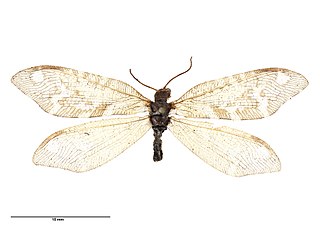
Endemism is the state of a species being found only in a single defined geographic location, such as an island, state, nation, country or other defined zone; organisms that are indigenous to a place are not endemic to it if they are also found elsewhere. For example, the Cape sugarbird is found exclusively in southwestern South Africa and is therefore said to be endemic to that particular part of the world. An endemic species can also be referred to as an endemism or, in scientific literature, as an endemite. Similarly, many species found in the Western ghats of India are examples of endemism.

The family Phylliidae contains the extant true leaf insects or walking leaves, which include some of the most remarkably camouflaged leaf mimics (mimesis) in the entire animal kingdom. They occur from South Asia through Southeast Asia to Australia. Earlier sources treat Phylliidae as a much larger taxon, containing genera in what are presently considered to be several different families.

Lymnaea stagnalis, better known as the great pond snail, is a species of large air-breathing freshwater snail, an aquatic pulmonate gastropod mollusk in the family Lymnaeidae. The great pond snail is a model organism to study parasitology, neurology, embryonal development and genetic regulation.
Neobola stellae is a species of ray-finned fish in the family Cyprinidae. It is endemic to Lake Turkana in Ethiopia and Kenya. It can reach a maximum length of 2.3 cm.

The West Papuan lorikeet is a species of parrot in the family Psittaculidae. It is found in New Guinea. Its natural habitat is subtropical or tropical moist montane forests.

The orange-breasted trogon is a species of bird in the family Trogonidae. It is a colorful, sedentary species that inhabits the lower canopy of the lowlands and forest of southern China, southeast Asia, Borneo, Sumatra and Java.

The large-toothed shrew or Mexican large-toothed shrew is one of 77 species within the genus Sorex. Registered on the IUCN Red List as vulnerable with a decreasing population, the Mexican large-toothed shrew has been recorded only 14 times in seven locations. The shrew is a member of the red-toothed shrew subfamily Soricinae, and the more taxonomically defined tribe Soricini. Members of the latter category exhibit long tails relative to body size.
Aglaodiaptomus is a genus of copepods in the family Diaptomidae. They are often bright red or blue due to carotenoid pigments.

Callitriche stagnalis is a perennial aquatic vascular plant species. Also known as pond water-starwort, C. stagnalis, may thrive in a variety of aquatic and subaquatic habitats, specially those exhibiting slowly moving to non-moving water. Although C. stagnalis does not pose a threat to humans, its reproductive rate may pose a threat to native vegetation in areas where it has been introduced, as the resulting dense vegetative mats frequently out-compete native species.

Stella's lorikeet is a species of parrot in the family Psittaculidae. It is endemic to New Guinea. Its natural habitat is subtropical or tropical moist montane forests.

Echinostoma revolutum is a trematode parasite of which the adults can infect birds and mammals, including humans. In humans, it causes echinostomiasis.

Tanymastix stagnalis is a species of Anostraca that lives in temporary pools across Europe. It may reach up to 2 cm (0.8 in) in some areas and has 11 pairs of bristly, flattened appendages. It swims upside-down and filters food particles from the water. It is the only species of Anostraca in Ireland, having been discovered in Rahasane Turlough in 1974.

Chirocephalus diaphanus is a widely distributed European species of fairy shrimp that lives as far north as Great Britain, where it is the only surviving species of fairy shrimp and is protected under the Wildlife and Countryside Act 1981. It is a translucent animal, about 0.5 in (13 mm) long, with reddened tips to the abdomen and appendages. The body comprises a head, a thorax bearing 11 pairs of appendages, and a seven-segmented abdomen. In males, the antennae are enlarged to form "frontal appendages", while females have an egg pouch at the end of the thorax.

Gamochaeta is a genus of flowering plants in the family Asteraceae. There has not always been agreement among botanists regarding its status as a recognized genus, but it has become more accepted in recent years. It currently includes many plants that previously belonged in genus Gnaphalium. Like many species of Gnaphalium, many Gamochaeta are called cudweeds or everlastings.
Gamochaeta stagnalis, the desert cudweed, is a species of flowering plant in the family Asteraceae. It is native to Mexico, Guatemala, and the southwestern United States.
Burkholderia stagnalis is a bacterium from the genus of Burkholderia. Burkholderia stagnalis belongs to the Burkholderia cepacia complex.
Andinosaura stellae is a species of lizard in the family Gymnophthalmidae. It is endemic to Colombia.

Euosmylus stellae is an endemic species of New Zealand lacewing that was first described by Robert McLachlan in 1899. It is the only species in the genus Euosmylus. The species ranges from the North Island Volcanic Plateau to the middle of the South Island, including Arthur's Pass and the Ashley Gorge. It was named in honour of George Hudson's daughter Stella.
Mnesarchella stellae is a species of primitive moths in the family Mnesarchaeidae. It is named in honour of Gibbs' mother Florence Stella Gibbs. This species is endemic to New Zealand and can only be found in the Nelson area for recording specimen localities as described by T. K. Crosby. This species is the largest in the Mnesarchella genus but otherwise is similar in appearance to other species contained in that genus. This species prefers very damp, dark native beech forest with plentiful moss and lives at altitudes of between 420 and 750 m. Adults of this species are on the wing in December and January.
Boana stellae is a frog in the family Hylidae, endemic to Brazil. Scientists know it from the type locality: between 200 and 600 meters above sea level on the Araucaria plateau in Rio Grande do Sul.













